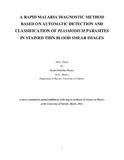| dc.description.abstract | Malaria is the leading cause of morbidity and mortality in tropical and subtropical countries. Conventional microscopy used in diagnosis of the disease has occasionally proved inefficient since it is time consuming and results are difficult to reproduce. Alternative diagnosis techniques which yield superior results are quite expensive and hence inaccessible to developing countries where the disease is endemic.
In this work, an accurate, rapid and affordable model of malaria diagnosis using stained thin blood smear images was developed. The method makes use of the morphological, colour and texture features ofPlasmodium parasites and erythrocytes. Images of infected and non-infected erythrocytes were acquired, pre-processed, relevant features extracted from them and eventually diagnosis was made based on the features extracted from the images. Diagnosis entailed detection of Plasmodium parasites, differentiation of different Plasmodium parasite stages and species, as well as parasitemia estimation.
Image pre-processing entailed reducing the size of the acquired images to speed up processing and median filtering to remove salt and pepper noise. Neural network classifiers were then trained and used to detect and determine the life stages and species of Plasmodium parasites. Template matching technique was used to approximate the number of erythrocytes in the images and hence estimate the degree of infection (parasitemia).
Classification accuracy of 95.0%, 92.7%, 92.0%, and 79.7% for detection of infected erythrocytes, stages determination, species identification, and parasitemia estimation respectively was achieved with respect to results obtained by expert microscopists. The study revealed that artificial neural network (ANN) classifiers trained with colour, morphological, and texture features of infected stained thin blood smear images are suitable for detection and classification of Plasmodium parasites into their respective stages and species. It was further shown that ANN classifiers can be trained to perform image segmentation. | en_US |

